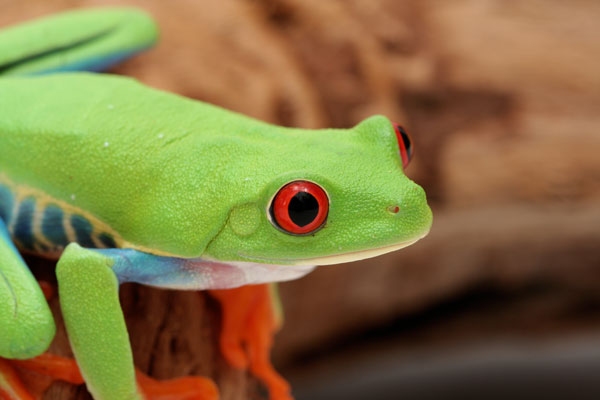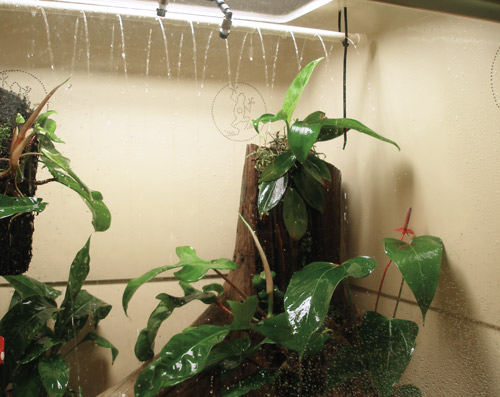Bonus content from the August 2011 REPTILES magazine article "Ready for Red-Eyes?"
Although keeping red-eyed treefrogs (Agalychnis callidryas) in captivity is rewarding in its own right, breeding them provides a new sense of accomplishment and allows you to observe fascinating behavior. Start with at least a pair of mature frogs, or better, a large group containing multiple males and a couple of females. The size difference between adult males and females makes sexing them a cinch. Males typically mature between 2 and 2 1/2 inches, while females can grow up to just under 3 inches in length. To further confirm the sex of a frog, look for small brown nuptial pads at the base of each hand. These develop only in males ready for reproduction. You can also tell males apart from females by their vocal ability. Females remain silent. Juveniles cannot be sexed, but they mature toward the end of their first year.
Like many amphibians, breeding red-eyed treefrogs in captivity requires careful manipulation of their environment. Only healthy, established frogs should be exposed to these conditions. Start by cutting back on misting the terrarium, down to as little as two light sprays per week, and reduce the temperature by 5 degrees Fahrenheit. Frogs may not require as much food during this time, so feed in smaller quantities, all the while monitoring their body condition carefully to ensure that they remain in good health. After a month, return the terrarium to normal temperatures, mist heavily at least twice a day, and begin feeding a variety of foods every night. Males ready to breed will develop nuptial pads and start calling. Provided females are well-fed and in proper condition, they will swell with eggs. If females look especially fat and males are calling regularly, it is time to move frogs to a rain chamber.

Gina Cioli/i5 Studio
Rain Chambers for Red-Eyed Treefrogs
In the wild, red-eyed treefrogs breed en masse during or following rains. To replicate these conditions in captivity, most breeders find it necessary to create a rain chamber. A rain chamber can be made out of just about any waterproof container – from a large aquarium to a modified plastic garbage bin. Positioned at the top of the terrarium, you will need a spray bar, which is connected to a small pump. When the pump is turned on, a rain storm is simulated and water drops descend from above. The pump should be submerged in 2 to 3 inches of water at the bottom of the rain chamber and plugged into an electrical timer, so that it automatically turns on, raining for a couple hours multiple times each night.
In the water, place several large, broad-leaved tropical plants for egg deposition. These can be grown hydroponically in ceramic pots filled with LECA (lightweight expanded clay aggregate) and covered with sphagnum moss on top, or grown epiphytically on cork bark slabs or tree fern panels. Additionally, consider floating a piece of cork bark on the water to give frogs some footing if they fall in and need a quick way out. Finally, add an aquarium heater with a built-in thermostat, and set it to around 80 degrees.

Devin Edmonds
In the wild, red-eyed treefrogs breed during or following rains. Rain chambers help breeders replicate these conditions in captivity.
Tips and Tricks For Red-eyed Treefrogs
1. Competition between males may help encourage breeding, so have a male to female ratio of at least 2:1 and introduce males to the rain chamber a day or two before females.
2. If possible, time the move to the rain chamber with the onset of a thunderstorm. Anecdotal evidence suggests changes in barometric pressure associated with rainstorms may promote breeding success.
3. Change part of the water daily. If water quality deteriorates, accumulated waste will rain down on frogs and lead to health problems.
4. Move frogs back to their normal terrarium if breeding does not occur after one to two weeks, feed heavily for another week, and then try again.
In the wild, female red-eyed treefrogs deposit eggs on smooth plant leaves overhanging water. In captivity, eggs are also often laid on the side of the terrarium or rain chamber. If eggs are positioned over water, they can be left in place while tadpoles develop. Remove the adults after you see the eggs and turn the rain chamber pump off.
Within one week tadpoles wriggle free and drop into the water below. Alternatively, plant leaves with eggs adhered to them can be cut off and positioned above water in a separate aquarium, stuck to glass with tape. Females often deposit multiple clutches in one night, with clutch size varying from around one dozen to more than 100.
During the first week, tadpoles remain mostly motionless on the bottom of the aquarium. Once they begin to move around, start performing regular partial water changes and feeding finely ground flake fish food. A sponge filter can be used to help maintain water quality. If given a water temperature of 75 degrees, most tadpoles complete metamorphosis within eight weeks, but some will take longer. Once front arms develop, the little tailed red-eyes are able to use their toe pads to scale glass, so make sure there is a screen cover on the aquarium. It is helpful to put a piece of driftwood or cork bark in the water for newly metamorphosed frogs to climb onto.
Once they can climb out of the water on their own, move recently metamorphosed red-eyes to a simple setup with moist paper towel, a water bowl and a few plants. Baby frogs are prone to desiccation, so make sure the enclosure stays moist. Other than that, the setup can be similar to that of the adults. Ten to 20 froglets can be housed in a 5- or 10-gallon aquarium for the first month. As they grow, group froglets by size. This will help prevent smaller individuals from being outcompeted for food by larger siblings.
After their tails are absorbed, flightless fruit flies and one-eighth inch long crickets are eagerly eaten each night. Lightly coat each offering in high-quality nutritional supplements.



